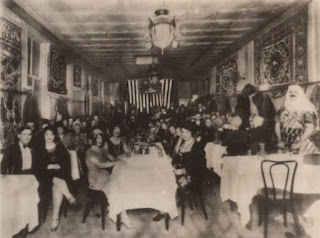New York City, 1924-1954
In 1913, Elias and Joseph Kirdahy opened the Kirdahy Brothers’ Oriental Restaurant on Washington Street in Lower Manhattan. The neighborhood, known as Little Syria, was the first Arab enclave in the United States. In the mid-1920s, the brothers renamed their restaurant The Sheik after Rudolph Valentino’s wildly popular silent film. According to legend, actor John Barrymore, a frequent guest, suggested the new name. The decision proved pivotal, sparking a trend among Arab American restaurateurs to adopt names drawn from Hollywood’s romanticized visions of the Arab world. The business card shown above and three menus recall this restaurant that, through the choice of a new name, rebranded itself in a way that helped shape American food culture.
Bohemians and journalists “discovered” the restaurants of Little Syria around the turn of the twentieth century, just as they were venturing into Little Italy and Chinatown in search of novel dining experiences. In 1902, the New York Times reported, “that explorer who penetrates to the interior of one of the Syrian restaurants down on Rector or Washington Street will encounter a suave and smiling proprietor, who will present him the menu card with a flourish. The menu looks exactly as if it were written in shorthand, only up and down the page instead of across. It sounds like shorthand, too, when the proprietor reads it aloud. The patrons gather around, much interested, and help translate.”
The 1902 article also noted the complete absence of women in the restaurants of Little Syria. By the 1920s, however, this had completely changed, as seen in this photograph of The Sheik. Arab American restaurateurs offered flavorful foreign dishes at low prices and cultivated an exotic and welcoming atmosphere for their guests—much like their Italian and Chinese counterparts in other sections of the city.


As the residents of Little Syria moved to other parts of the city, an Arab American hub emerged around Fifth Avenue between 25th and 35th Streets in the Garment District. The Sheik relocated there in 1935. Other nearby restaurants included Bagdad at 4 W. 28th Street and Mecca at 6 E. 30th Street. This menu is from the late 1930s.
While the mid-1950s menu below is bilingual, its format follows Arabic conventions, reading from back to front, with the fold on the right to accommodate Arabic’s right-to-left script. Another distinctive feature is the notice, “Prices indicate what we have today.” Prices are listed for forty items—about twice as many dishes as appeared on earlier menus. Several offerings reflect Egyptian and Turkish influences.



The Sheik operated in various locations and under different owners for nearly 60 years. Nostalgia was already in the air in 1962, when the guidebook New York on Five Dollars a Day noted, “Your grandparents will probably remember this exotic Middle Eastern restaurant from the days when it was known as ‘Kirdahy Brothers’ and located on the Lower East Side.” While such themed restaurants have largely disappeared, many dishes first popularized by Arab American restaurateurs—hummus, shawarma, kabobs, baklava, pita bread, and more—have become staples of the American diet, especially in cities and among health-conscious consumers.
Notes 1. Little Syria, also known as the Syrian Colony, was a tenement district located just north of Battery Park, with a population of about 6,000 people at the turn of the twentieth century. “Syrian Colony of New York and Its Characteristics,” New York Times, 25 May 1902.
2. The Son of the Sheik (named after the Rudolph Valentino sequel in 1926) was a popular theme restaurant that operated at various locations in New York and was known for its belly dancers and exotic decor.




















1 comment:
So interesting, Henry. Love hummus. A red menu is a rare sight!
Post a Comment